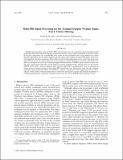Multi-PRI Signal Processing for the Terminal Doppler Weather Radar. Part I: Clutter Filtering
Author(s)
Cho, John Y; Chornoboy, Edward S.
DownloadJTECH1730.pdf (227.2Kb)
PUBLISHER_POLICY
Publisher Policy
Article is made available in accordance with the publisher's policy and may be subject to US copyright law. Please refer to the publisher's site for terms of use.
Terms of use
Metadata
Show full item recordAbstract
Multiple pulse repetition interval (multi-PRI) transmission is part of an adaptive signal transmission and processing algorithm being developed to aggressively combat range–velocity ambiguity in weather radars. In the past, operational use of multi-PRI pulse trains has been hampered due to the difficulty in clutter filtering. This paper presents finite impulse response clutter filter designs for multi-PRI signals with excellent magnitude and phase responses. These filters provide strong suppression for use on low-elevation scans and yield low biases of velocity estimates so that accurate velocity dealiasing is possible. Specifically, the filters are designed for use in the Terminal Doppler Weather Radar (TDWR) and are shown to meet base data bias requirements equivalent to the Federal Aviation Administration’s specifications for the current TDWR clutter filters. Also an adaptive filter selection algorithm is proposed that bases its decision on clutter power estimated during an initial long-PRI surveillance scan. Simulations show that this adaptive algorithm yields satisfactory biases for reflectivity, velocity, and spectral width. Implementation of such a scheme would enable automatic elimination of anomalous propagation signals and constant adjustment to evolving ground clutter conditions, an improvement over the current TDWR clutter filtering system.
Date issued
2005-05Department
Lincoln LaboratoryJournal
Journal of Atmospheric and Oceanic Technology
Publisher
American Meteorological Society
Citation
Cho, John Y. N. and Chornoboy, Edward S. “Multi-PRI Signal Processing for the Terminal Doppler Weather Radar. Part I: Clutter Filtering.” Journal of Atmospheric and Oceanic Technology 22, 5 (May 2005): 575–582 © 2005 American Meteorological Society
Version: Final published version
ISSN
0739-0572
1520-0426